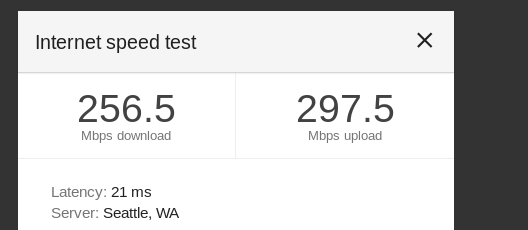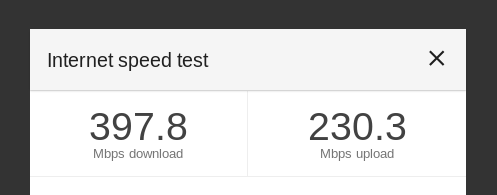Ugg, you're sort of right. On the openwrt page, the openwrt boot logs only show eth0. The ddwrt boot logs show eth0 and eth1.
I ordered a WRT1900ACS. Its openwrt boot logs have both.
Ugg, you're sort of right. On the openwrt page, the openwrt boot logs only show eth0. The ddwrt boot logs show eth0 and eth1.
I ordered a WRT1900ACS. Its openwrt boot logs have both.
Usually, ipq806x devices have two CPU ports - both connected to the same switch, one used for WAN, the other for LAN. The provided bootlogs in the OpenWrt wiki also show both interfaces (eth0 and eth1) being detected, although only one of them (eth0) actually gets configured, which is rather uncommon (maybe an oversight? obviously with the common setup you don't need to configure both CPU ports, although that is a better solution).
I tried a WRT1900AC v1 running OpenWRT 18.06.2.
Here's IPv4 without the hardware NAT:

And IPv6 without the hardware NAT:

IPv4 with the hardware NAT:

The IPv6 results vary a lot. Here is one of the high results:

Purchased a Linksys WRT32X and flashed OpenWRT on it today, verison OpenWrt 18.06.2 r7676-cddd7b4c77 / LuCI openwrt-18.06 branch (git-19.020.41695-6f6641d)
I am not able to get more than 500M up/down when connected to the router via ethernet. I have a GB connection to my home via Centurylink.
I am not sure where to start troubleshooting. Where is a good place to start?
are you running SQM?
Did you enable software flow offloading and hardware flow offloading?
Do two ethernet interfaces show up on WRT32X (eth0 and eth1)? Otherwise you'll probably only reach 1GB half duplex.
Centurylink gives slower IPv6 than IPv4. So it's probably easiest to keep the IPv6 disabled until you reach the expected speeds with IPv4.
Test with PC connected directly to the modem.
My experience with the WRT32X is it could NAT at the Ethernet line speed (net 930 Mb or so) without turning on any offloading. The test was conducted with two PCs running iperf3.
I ended up disabling the software offloading. It was working find for outgoing connections, but when I tried to ssh into the server from a different ISP, the connection would stall out.
I have the same router, and I tried following the steps on this thread, but I was kind of stuck at the line quoted above. What did this accomplish? From that drop-down menu you have pictured, I typed eth1.201 as a custom interface. In that same menu, it now shows up as a software device (exactly like you have pictured above). I guess I was expecting eth1.201 to show up under network/switch so that I can enable vlan tagging, but it doesn't. When I read your post, I thought that creating that custom interface was going to help me enable vlan tagging, but maybe I misunderstood.
Anyway, Thanks in advance for any help.
@mlsfit138, welcome to the community!
VLAN tagging would be under Network > Switch
Example pic:
Perhaps you should make a new thread and explain your issue in full.
First you need to know whether or not WAN traffic does go through the switch. Whether it does or not varies by model, but on Gb models that are not x86 it almost always does.
On the switch page, the "add" button under the list of VLANs will add a new VLAN. If you do that first, the new VLAN should also show up in the list of choices in interface physical settings.
@mk24 @lleachii
Thanks for the fast responses, and for the welcome!
I was quoting and responding to bluelightning32's post because, by coincidence, he was in exactly the same situation that I'm in; same router, same ISP, etc. He also came to the same problem that I ran into while following Localhoser's guide: WLAN does not show up under network/switch. Apparently, bluelightning found a solution, he created a custom interface. I followed his advice, expecting wlan to show up under network/switch (so that I could enable vlan tagging). It didn't, and I feel like maybe bluelightning left something out (maybe because it should be completely obvious), or I misinterpreted something. I was hoping that he would be able to shed some light on what should have happened after creating that custom interface.
I had to give up for today, because I ran out of time. In fact, I wouldn't have been able to post my question without giving up first, because my old wndr3800 was not able to provide me with internet access. Strangely though, if I went to the "diagnostics" page in luci, I could ping google and other servers. I was just not able to do so from my computer. I guess that this had something to do with vlan tagging (vlan tagging has something to do with partitioning networks, right?)
Anyway, I can't spend any more time on this today. I plugged my non-open source zyxel router/modem back in for now so that I can at least have internet access at home.
This was really all a test to see if openwrt would work for me with with centurylink gigabit fiber. I don't like running proprietary firmware on my router, and I wanted to try out my old slow router before shelling out for a new router like the r7800 or the linksys acs3200. I have reason to think that they will not be able to support gigabit speed over PPOE.
Anyway, thanks again.
What model do you have? There are all different models mentioned in this thread.
If it has dedicated single Ethernet ports direct from the CPU to outside, you just need to add a tag in the physical settings. There would be no switch involved.
Netgear's WNDR3800. What drew me to bluelightning's post is that he mentions this specific router in his first post in this thread. I guess I should have been more clear, and posted the router model more prominently.
Honestly, that is the router I bought back in ~2012 (and yeah, it was running openwrt the whole time). My (free) Zyxel is MUCH faster. I'm not really interested in going back to that router (the netgear wndr3800). I was hoping this would be a quick test because as stated before: same router, same service provider, same gigabit fiber connection, same PPPOE requirement as bluelightning. However, I couldn't get it to work after spending several hours on it.
To be honest, I'm not sure if it'd be worth the time (and frustration) it would take to run this experiment again. I think that I'd rather just buy a new router with open source support and hope for the best. I'll probably start a thread looking for people who have had success with newer routers that also have to double as PPOE modems while achieving full gigabit speed. If not, I just might run this Zyxel. It works fine, I just don't know if I should trust it.
Thanks everyone! I just bought a refurbished wrt32x (for $100!), and followed localhoser's guide, and this worked like a charm.
This topic was automatically closed 10 days after the last reply. New replies are no longer allowed.